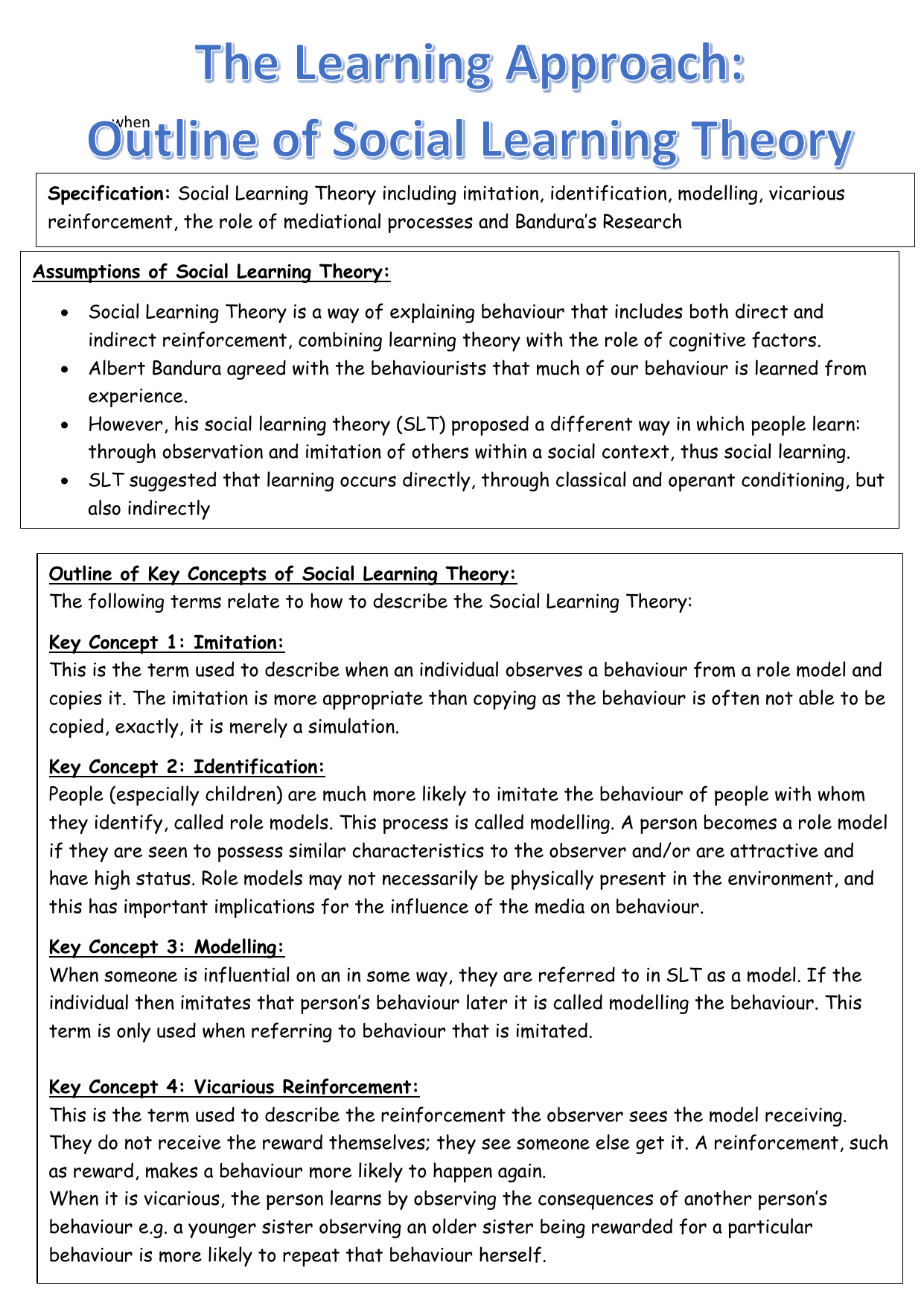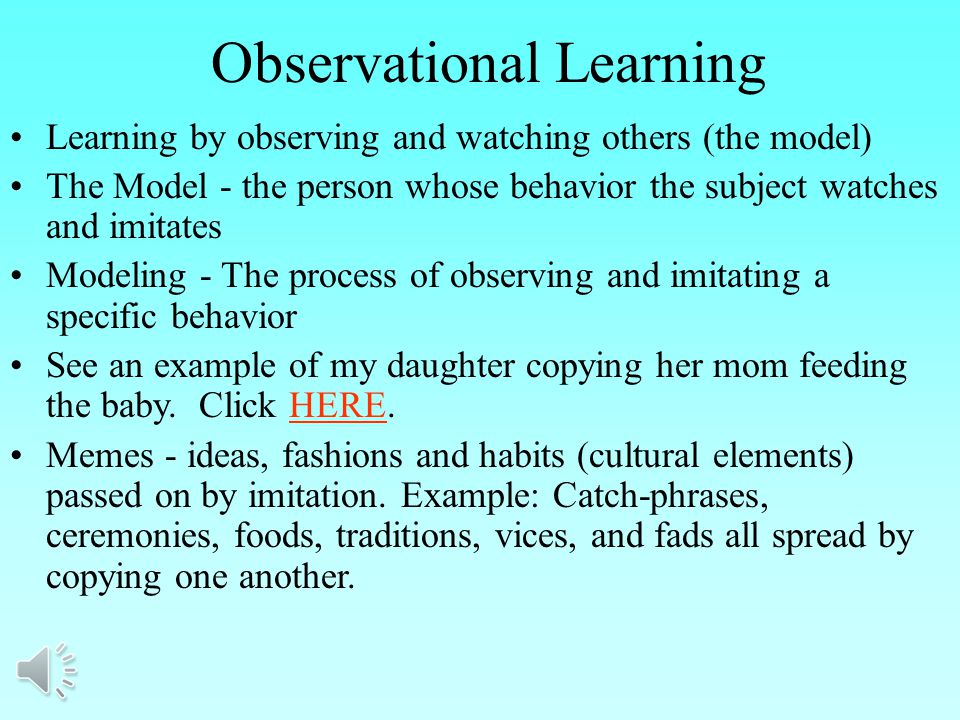Describe a Behavior That You Learned by Imitation
The key to imitation is the ability to imitate novel movements and behaviors. Next imagine that you grew up in a.

Albert Bandura S Social Congnitive Theory Centers Around The Idea Of Observational Learning Observational Learning Ap Psychology Fatherhood
Language development offers an.

. Culture Learning Describe an example of imitation learning when you were a child. An employee on his or her first day of a new job might eagerly look at how others are acting and try to act the same way to fit in more quickly. Imitation is also a form of social learning that leads to the development of traditions and ultimately our culture.
Language is acquired through Operant Conditioning otherwise known as reinforcement and imitation. Imitation from Latin imitatio a copying imitation is a behavior whereby an individual observes and replicates anothers behavior. The principle of similarity is important here since it is the social aspect of imitation that plays the major role in this context.
Imitation or copying anothers behavior begins in infancy and continues throughout the lifespan. For 1-year-olds imitation follows a four-step process. Imitation in psychology the reproduction or performance of an act that is stimulated by the perception of a similar act by another animal or person.
Imitation may be either dramatic or idealisticDramatic imitation is based on mental image formed by the individual. The imitation method of teaching focuses on breaking apart skills into components providing the learner with a model of the target behavior and rewarding the learner for demonstrating the response immediately after the model. Imitation means copying the words facial expressions or actions of another person.
There is nearly 100 contingency and congruency between observing a visual image of your own hand and performing an action with that hand. Most children learn everything from gross motor movements to speech to interactive play skills by watching parents caregivers siblings and peers perform these behaviors. The uses of imitation in teaching and in learning.
November 24 2021 by Essays. Discuss concepts such as imitation social reciprocity and exploration. Imitation is the tendency of the child to act according to what he sees or observes.
Observation and imitation of a sorting strategy by. This social function of imitation becomes less important as children grow older since. In this discussion you will consider attachment styles and potential outcomes when conditions are not ideal for attachment as well as the.
These mirror neurons allow us to mirror or copy what another person is doing. His theory was essentially that children learn to speak by copying the words and sounds heard around them and by having their responses strengthened by the repetitions corrections and other reactions that adults provide. Modeling is one way in which behavior is learned.
Deferred imitation reproducing a behavior after a delay from its initial demonstration Electroencephalography EEG a method used to measure electrical activity in the brain Generalization the ability to apply something learned in one situation to a new situation Imitation observing then reproducing or copying a behavior Mirror neurons. SMCs for imitation of hand actions eg grasp are likely to be strong because they can be learned largely by selfobservation of ones own hand actions. Modeling is a kind of vicarious learning in which direct instruction need not occur.
That is what behavior or task did you learn that you used subsequently that you learned simply by watching someone else display the behavior. Students with autism lack the early development of their mirror neurons. Describe a behavior that you learned by imitation Answers can include things like tying shoes learning to speak and learning a sport.
For many of our children learning by observation may not occur naturally. It is this that enables babies to. The establishment of social imitation and patterns is vital to the survival of a species and to the development of a child and plays an important role in our understanding of the social nature of human learning as a whole.
Imitation is a crucial aspect of skill development because it allows us to learn new things quickly and efficiently by watching those around us. Through imitation you understood the rules strategies and how to play fairly without upsetting the other kids. Children imitate their peers because they want to communicate nonverbally and achieve a sense of belonging and closeness.
If those are the only 3 imitative movements a child has he still has mastered imitation. This is why building strong imitation skills is so important. This is sometimes known as observational learning or social learning.
Sometimes imitation is flattering but often its just annoying like. The concept of imitation is doing the same The goal is teaching a student this concept is not teaching to clap when I clap to stand when I stand and to sit when I sit. Sometimes particularly when we do not know what else to do we learn by modeling or copying the behavior of others.
As a descriptive term imitation covers a wide range of behaviour. Using either classical or operant conditioning as an example explain how learning can be adaptive. Posted by PLB Leave a Comment.
Find an answer to your question give an example of a behavior you learned by imitation mendozafrank96116 mendozafrank96116 12142021 Biology High School answered Give an example of a behavior you learned by imitation 2 See answers Advertisement. Young children frequently learn behaviors through imitation. One of the most prominent tendencies in children and adults is that of imitation.
Watching and listening processing the information attempting to copy a behavior and practicing. We have learned that attachment occurs due to safety needs but what if these needs were not met. Essentially it involves a model to which the attention and response of the imitator are directed.
When a person observes the behavior of another and then imitates that behavior he or she is modeling the behavior. In conclusion humans will follow the four steps of effective modeling proposed in Albert Banduras observational theory 1970 in order to learn various things through imitation such as violent behaviors and observation of a behavior in which they learn to mimic themselves.

4ba2a65851c600b31e0c827acc6da8db Webp 640 960 Parent Child Interaction Therapy Adolescent Therapy Therapy Activities

Pdf Imitation In Undergraduate Teaching And Learning

Giving Your Child P R I D E Love And Logic Messy Kids Mommy Inspiration

Pdf The Function Of Imitation In Humans

Types Of Imitation Institute For Learning And Brain Sciences I Labs

Social Learning Theory Social Learning Theory Learning Theory Learning Psychology

Pdf Imitation In Animals Evidence Function And Mechanisms

How Self Efficacy Helps You Achieve Your Goals Social Learning Theory Social Cognitive Theory Social Work Theories

Bandura S Theory Of Observational Learning Under Social Learning Theory Social Learning Theory Observational Learning Learning Theory

Social Learning Theory Handout

Observational Learning Ppt Video Online Download

By Three Methods We May Learn Wisdom First By Reflection Which Is Noblest Second By Imitation Which Is In 2022 Experience Quotes Learning Quotes Stoicism Quotes

Infographic Social Learning Theory Infogram Social Learning Theory Learning Theory Social Work Theories

Bandura S Social Cognitive Theory An Introduction Excerpt Youtube Social Learning Theory Learning Theory Social Cognitive Theory

Giving Your Child P R I D E Modern Parents Messy Kids Love And Logic Child Advocacy Messy Kids

Tech Design And Society Speech Language Therapy Language Therapy Aac

Children Learn Through Imitation Institute For Learning And Brain Sciences I Labs

Why Imitation In Early Childhood Is Crucial Jacobs Foundation

Comments
Post a Comment